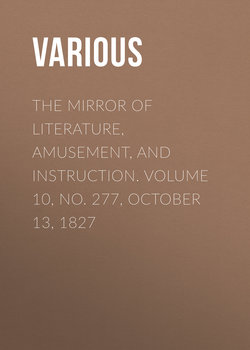Читать книгу The Mirror of Literature, Amusement, and Instruction. Volume 10, No. 277, October 13, 1827 - Various - Страница 1
THE PALACE AT STOCKHOLM
ОглавлениеThe palace at Stockholm is the redeeming grace of that city.—Stockholm "not being able to boast any considerable place or square, nor indeed any street wider than an English lane; the exterior of the houses is dirty, the architecture shabby, and all strikes as very low and confined. Yet the palace must be excepted; and that is commanding, and in a grand and simple taste." Such is the description of Stockholm by Sir Robert Ker Porter; but, as he admits, he had just left the city of St. Petersburgh, and being probably dazzled with the freshness of its splendour, Stockholm suffered in the contrast.
But Sir R.K. Porter is not entirely unsupported in his opinion. Mr. James, in his interesting "Journal of a Tour in Sweden, &c." published in 1816, describes the suburbs of Stockholm as "uniting every beauty of wild nature, with the charms attendant upon the scenes of more active life; but the examples of architecture within the town, if we except the mansions of the royal family, are not of a style at all corresponding with these delightful environs. The private houses make but little show; and the general air of the public buildings is not of the first style of magnitude, or in any way remarkable for good taste. One point, however, may be selected, that exhibits in a single prospect all that the capital can boast of this description. There is a long bridge of granite, connecting the city in the centre with the northern quarters of the town: immediately at one extremity rises the royal palace, a large square edifice, with extensive wings, and of the most simple and elegant contour; the other extremity is terminated by an equestrian statue of Gustavus Adolphus, forming the chief object of a square, that is bounded on the sides by handsome edifices of the Corinthian order; one the palace of the Princess Sophia, the other the Italian Opera-house."
Mr. A. de Capell Brooke, who visited Stockholm in the summer of 1820, describes the palace as "a beautiful and conspicuous object, its walls washed by the Baltic."—It is square, on an elevated ground, has a spacious court in the centre, and is in every respect worthy a royal residence. Near the entrance are two large bronze lions, which are admirably executed. "The view of the palace from the water," says Sir R.K. Porter, "reminds us of Somerset House, though it far exceeds the British structure in size, magnificence, and sound architecture." It contains some good paintings, and a fine gallery of statues, chiefly antique, collected by the taste and munificence of Gustavus III. The Endymion is a chef d'œuvre of its kind, and the Raphael china is of infinite value, but a splendid example of genius and talent misapplied.
All travellers concur in their admiration of the site and environs of Stockholm, and in deprecating the malappropriation of the former, Porter says, "The situation of this capital deserves finer edifices. Like St. Petersburg, it is built on islands; seven, of different extent, form its basis; they lie between the Baltic and the Malar lake. The harbour is sufficiently deep, even up to the quay, to receive the largest vessels. At the extremity of the harbour, the streets rise one above another in the form of an amphitheatre, with the magnificent palace, like a rich jewel in an Æthiop's ear, in the centre."
Mr. Brooke describes the situation of the city as "singular and even romantic. Built on seven small rocky islands, it in this respect resembles Venice. A great part of the city, however, stands upon the steep declivity of a very high hill; houses rising over houses, so that, to the eye, they seem supported by one another. Below, commerce almost covers the clear waters of the Baltic with a tall forest of masts; while far above, and crowning the whole, stands the commanding church of St. Catherine. From the top of this the eye is at first lost in the boundless prospect of forest, lake, and sea, spreading all around: it then looks down upon Stockholm, intersected in all directions by water; the royal palace; and lastly, ranges over the forests of pines extending themselves almost down to the gates of the city, spotted with villas, and skirted in the most picturesque manner by the numerous beautiful lakes, which so pleasingly relieve the beauties of the country. The other objects, which will repay the curiosity of the stranger in inspecting them, are, the royal palace; the military academy at Cartberg; the arsenal; the senate house; the Ridderholm, where the kings of Sweden are interred; the cabinet of natural history; the annual exhibition of paintings; the fine collection of statue in the palace."
